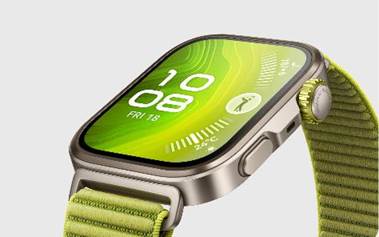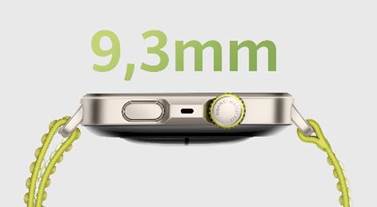Fitness-focused
smartwatches are more than just digital accessories; they are instruments that
enable healthier lifestyles. They support your goals both in and out of the gym
with features like real-time tracking, health monitoring, and inspiration. Key characteristics
such as lengthy battery life, dependable tracking, and app connection transform
an ordinary watch into a personalized coach. The Huawei Watch Fit 4 Pro is one such product that combines functionality, design,
and affordability. Investing in the proper smartwatch leads to more progress,
fewer excuses, and a better understanding of your body's demands. Stay active
and educated, and let your wristwatch direct you to greater fitness.

How Is Wearable Tech Evolving in 2025?
Rise of Health-Focused Wearables
More
devices are now prioritizing overall wellness over simple fitness tracking.
Wearables in 2025 provide real-time stress monitoring, hydration tracking, and
blood pressure readings. These tools assist users in managing chronic
conditions and detecting potential health issues. With FDA-approved sensors
becoming more prevalent, wearables serve as small diagnostic centers. Instead
of simply providing raw data, brands want to provide users and clinicians with
actionable insights. Products such as the Huawei Watch Fit4 Pro now offer daily
health scores and personalized advice. This trend means that consumers are
using technology to actively manage their health rather than just track it.
AI-Powered Personal Assistants on Your Wrist
Smartwatches
are growing into fully functional AI assistants. Voice commands are becoming
smarter, faster, and more intuitive. In 2025, AI in wearables will be able to
understand user behaviors, provide reminders, arrange appointments, and even
write summaries of texts or emails. Devices make context-aware suggestions,
such as reminding you to drink water after an exercise or recommending a break
during high-stress hours. Wearables function as a dependable second brain by
combining machine learning and personal data. This hands-free experience allows
users to complete activities more efficiently, making smartwatches an
indispensable tool in both professional and personal life.
Integration with Smart Home Ecosystems
Wearables
are evolving into smart home command centers. These days, users can control
security systems, lighting, and thermostats from their wrists. Companies are
highlighting the smooth integration of wearable technology with household
appliances. By 2025, controlling the environment at home will be simple and
intuitive thanks to advanced speech integration and gesture control. Imagine
using a simple wrist flick to dim the lights or unlock your front door.
Wearables can automatically change settings and understand context thanks to
this extensive connectivity. For instance, when your stress level rises, your
device may turn down the lights. These days, wearables are an important
component of an intelligent, networked home.
Top Innovations Reshaping Wearable Tech
Skin Patches for Continuous Health Monitoring
Skin
patches are changing the way we collect health data. These ultra-thin, flexible
gadgets adhere directly to the skin and measure glucose levels, moisture, and
body temperature. They use microfluidics and biosensors to provide lab-quality
data without using needles or cables. By 2025, sportsmen, diabetic patients,
and even hospitals will be using patches. Their non-invasive nature makes them
suitable for long-term use. When some patches detect aberrant readings, they
transmit a warning to your wearable or smartphone. As accuracy and battery life
increase, skin patches are projected to become a common tool for health
monitoring.

Sustainable and Flexible Wearable Materials
Wearable
design in 2025 will be based on eco-friendly innovations. Manufacturers are
switching to biodegradable and recyclable materials to lessen their
environmental impact. Flexible fabrics and printed electronics now enable
wearables to bend, stretch, and breathe like natural textiles. This makes
gadgets more comfortable and suited for prolonged use. Engineers are employing
organic semiconductors and environmentally friendly inks to construct screens
and sensors on flexible substrates. These materials not only improve
performance but also align with global sustainability objectives. Users can now
select wearables that reflect their environmental commitment while maintaining
feature quality and durability.
Battery-Free Wearables and Energy Harvesting
Battery
anxiety is fading as wearables start to power themselves. Energy harvesting
technology enables devices to generate electricity from body heat, movement, or
even solar energy. This innovation eliminates the need for frequent charging,
paving the way for thinner, lighter designs. Smart rings and fitness bands will
already run on thermoelectric generators and kinetic energy by 2025. These
self-sustaining devices are ideal for remote operations or emergency
situations. While still in their early stages, battery-free wearables
foreshadow a future in which technology seamlessly integrates into daily life
with no maintenance interruptions, freeing users from cords and charges.
Conclusion
Wearable
technology in 2025 is more intelligent, integrated, and user-centric than ever
before. It improves health, streamlines daily tasks, and integrates
effortlessly with smart ecosystems. With advancements such as energy harvesting
and AI-powered functionality, wearables are no longer just accessories; they
are indispensable tools. The huawei watch fit4 pro, for example, embodies this
trend with its health-focused, intelligent functions and stylish design. As the
market evolves, users may expect wearables that anticipate requirements,
preserve well-being, and promote sustainable living. Staying ahead requires
adopting technologies that not only connect but also care, adapt, and change
alongside their users.
